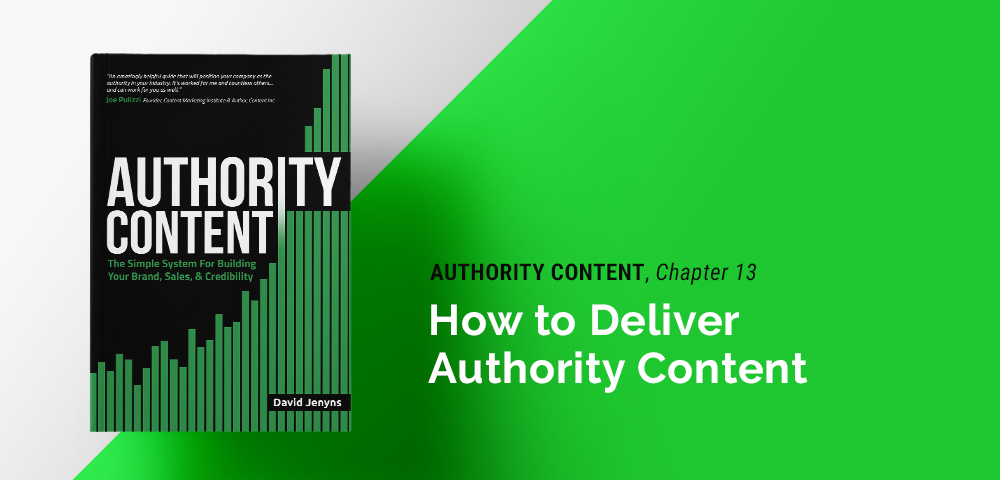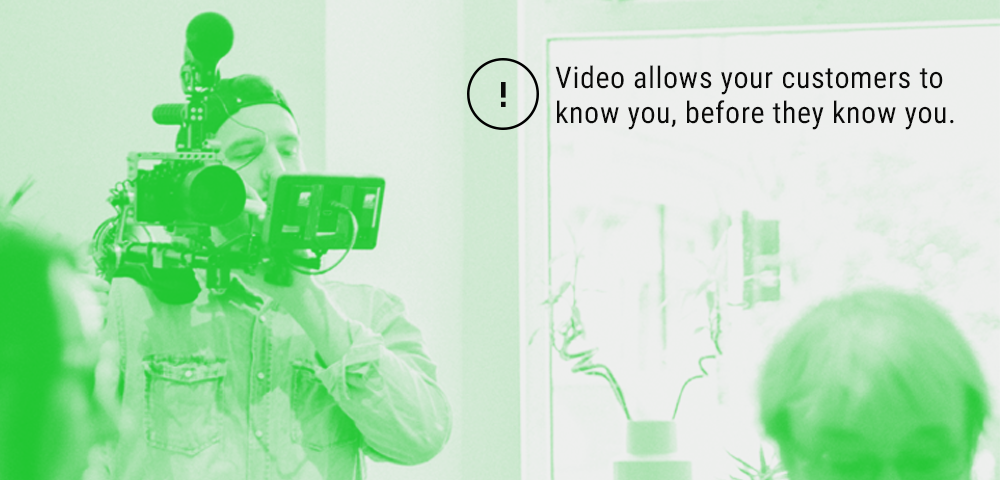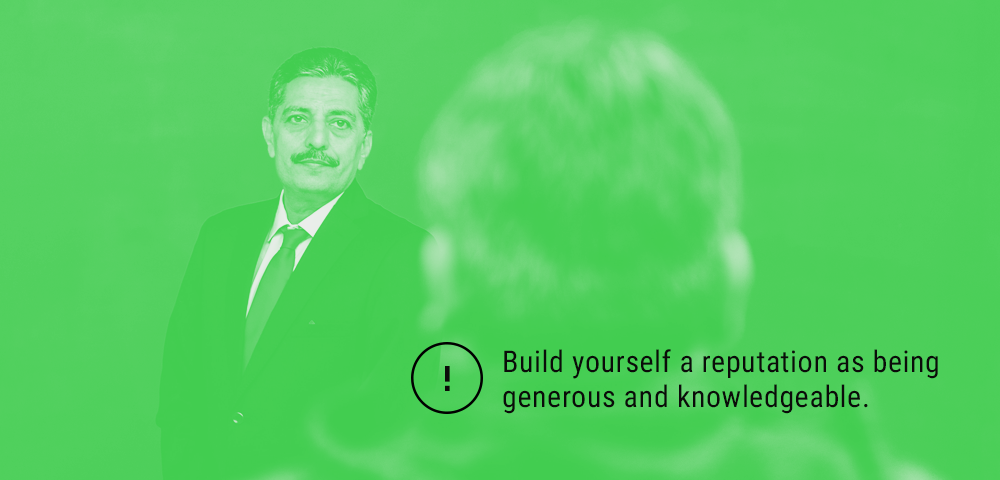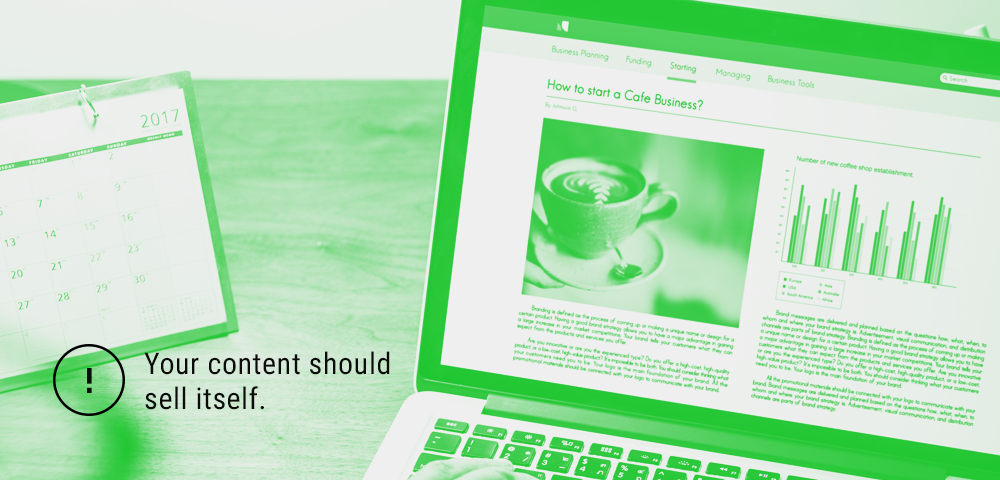Chapter index / Previous chapter / Next chapter
For the past few weeks we’ve been sharing chapters from David Jenyn’s book Authority Content. The chapters so far have included a lot of great advice about establishing yourself as an authority, with everything from how to ensure your website is set up correctly through to how to run your very first workshop. While all of that information has been extremely valuable, we are very excited to share another chapter with you which details a process for delivering authority content on your website and social channels.
If you read the post on filming your workshop, then you were probably wondering what exactly was going to be done with all of that footage.
Well, this is it.
In Chapter 13 of Authority Content, David shares exactly how to create content and repurpose it so you have a continuous stream to keep your site and platforms updated for many months at a time. This of course will help with your SEO, but will also keep your audience engaged and provide a good user experience.
So, get a pen and paper ready, it’s time to take some notes!
CHAPTER 13: TURNING ONE VIDEO INTO DOZENS
If you’ve fully applied everything we’ve discussed so far, not only are you ready to maximise the benefits of the promotional stage of Authority Content, but you should also be able to fully appreciate why the steps described in the next few chapters are so powerful.
You’ll be able to see with absolute clarity how these remaining pieces complete the puzzle and provide your business with a strategy that is organised, powerful, flexible and easy to repeat again and again, as often as you need.
It probably won’t surprise you in the least to learn that we’re going to start with some video marketing. Before we begin however, I want to take a moment to talk about video. You’ve already read about how invaluable it was with the Metastock project and you’ve probably already gathered that it’s fundamental to my current business projects.
I said that Authority Content isn’t just a fancy term for YouTube marketing and I think I’ve proved that already, but that doesn’t mean that video isn’t going to play a crucial part in this strategy. It’s just that YouTube is only one part of a larger strategy.
I mention this before we begin, because I need you to get on-board and accept how crucial this is to your marketing efforts. Video has been important for some years now and this trend shows no sign of slowing down.
Yes, new technology may come along that makes online video look better, run faster, and even become more interactive but it will still, at the heart of it, be video content that provides people with quick and easy visual access to the information they need.
Perhaps you’re already sold on this idea. Maybe you’ve already embraced video as a necessary element of your marketing efforts but if you haven’t, you need to change your view quickly. If you’re not using video in your marketing, I feel you’re being negligent in the promotion of your business. It will give you a clear competitive advantage.
I frequently experience occasions where I’m speaking to potential customers on the phone and they say that they feel like they already know me because they’ve been watching many of my videos over a period of weeks or even months. Can you even begin to appreciate how powerful that is? A potential customer, whom I’ve only just met, feels like they already know me? Do you recognise the level of trust that has already been created BEFORE I’ve ever personally spoken to that person?
No amount of articles and blog posts are going to be able to create that effect. It’s just not going to happen without utilising video.
Video is also going to be a huge time-saver for you. It’s the best way I know to be able to duplicate yourself. You record it once and yet it may be seen by hundreds, sometimes thousands or many hundreds of thousands of people.
My point is, that video is important and you need to embrace it and make it a crucial part of your marketing strategy. Sure your video efforts will start by repurposing some of your content from the workshop but I hope they extend well beyond that. Step out of your comfort zone and reap the rewards.
Time-Coding Your Workshop Video
At this stage, you’ve already got hours and hours of video that you recorded at your workshop. Now you’re going to chop it up and turn it into 30-40 individual videos, maybe more, each between three minutes and ten minutes in length.
This is a job you can do yourself, but it’s far better to assign it to members of staff. They don’t need to have any video editing skills because all they’re going to do is watch the footage and make time notations where a snippet should begin and end. It’s also a good idea to have someone write relevant titles and descriptions for each video, and if possible, identify a keyword or phrase that relates to the video.
I call this process “time-coding a workshop”. We set up a spreadsheet before watching the video to log everything. A note is made of the start and finish times, to the exact second, of each segment of video that feels like it could stand alone as a short video.
There’s a bit of a knack to this process and you’ll get better at it over time. But the idea is to identify portions of your workshop that when viewed in isolation, still make sense and teach at least one useful point. A way to test this is to imagine watching the video as if you know nothing about your business. If the video feels like it imparts something valuable, whether it’s a small useful tip, or a major, potentially life-changing philosophy, then it’s a good snippet.
Sometimes the snippet will be complete, with a beginning, middle and end. Sometimes it’ll end on a cliff-hanger and we’ll add a slide that says something like, “For more information, visit www…” That said, don’t overdo the cliff-hangers because you want your content to build you a reputation as generous and knowledgeable. Of course, there’s nothing wrong with holding back the occasional nugget that’s only available if someone buys the whole course but aim for a healthy balance.
The goal here is to set up all these doorways scattered on YouTube, each attracting people to them with the value of the content and then encouraging them to visit your site to learn more about your products and services.
And yes, you’re going to put up virtually your entire workshop online, in short chunks.
That might sound odd, as if it’s somehow going to devalue the video product you created, but this is the way I’ve always done it. In all those years, I’ve only ever had one person query it and in that instance I just refunded the guy.
Sure, there may be some people who trawl through your YouTube channel, spend hours working out the correct order and watching every single video online (and that’s ok), but the vast majority of people are happy to pay a fair price to have the whole workshop in order, in one place, with your additional bonuses.
Remember, the workshop video project is only a part of the overall strategy that is designed to “sell” the benefits of the products and services you provide and demonstrate that you and your brand are the knowledgeable “go to guys” for your industry.
So share your best content for free and you’ll be amazed at the Return on Investment (ROI).
Delivering Your Video Content
Once you’ve finished the spreadsheet, hand it over to your video editor as a guide to chopping up the content into individual video clips. You should also arrange for her to add an intro and outro graphic (or they can create one) that makes your work easily identifiable to the viewer and closes with a “call to action”, usually to visit your website.
Once your editor has finished, you should have 30-40 videos ready to go. Next, load them onto YouTube but mark them as “private” so they’re not available to the public. Use the title and descriptions created during the “time-coding” process to complete the profile for each video and think carefully about the action you want the viewer to take after they’ve viewed your video. The aim of the game is to get viewers onto your website where you can start to build a more developed relationship with them.
Always, always, always put your user first. While linking back to your site and creating engagement, your message needs to be helpful and never aggressive or spammy. The same holds true for the titles and descriptions you enter. Even though you’ve created these in advance, you should still take the time to review them in the context of the YouTube page once the video is uploaded. Keyword optimisation should be done carefully and never at the expense of creating something intelligible and interesting.
Similar rules apply from what we talked about earlier with regards to keyword selection and optimisation.
- Choose one primary keyword per content piece.
- Put that keyword once (not more than twice) in the title and description.
- Avoid formulas or set ways of optimising pages. Focus on what creates the best user experience. Stuffing an irrelevant keyword in the title for the sake of it, or cramming the same keyword over and over again in a description isn’t going to help anyone.
When all the upload and description work is completed, you can start releasing videos (changing their status from “private” to “public”) at a rate of, say, two or three per week, depending on how many videos you’ve managed to generate from the process. The goal is to have a three to six month period where every week, you have something new and interesting to share.
Great examples of this style of content can be found on our YouTube channel: www.authoritycontent.com/youtube
Repurposing Your Video Content
This is where the magic of repurposing starts to happen by turning these videos into fresh, unique blog posts. The best bit is, since you’ll be repurposing your original high-quality content, the standard stays high! This solves the problem many business owners face when working with freelancers to create content for their business.
Most freelancers either don’t know the subject matter well enough to write about it confidently, or they’ll charge like a wounded bull.
By repurposing your video content, you can hire people to help populate your blog simply by using transcripts of your videos and posting them as articles on your blog with the videos above them. This is a really simple process that anyone in your business can do.
Each time a video is set to “public” on YouTube, embed the video into a new post on your blog, and below the video, paste in the transcript. The transcript won’t appear anywhere else, so it won’t be seen as duplicate content, and embedding the video on your site helps it to rank better on YouTube. Like everything, you SEO optimise it and, of course, once the blog post is “live” you can share this article on your social media platforms.
Now that’s how you create a rock solid post without spending hours making it perfect. It’s great for your visitors and great for Google.
Curious to know what this sort of post looks like? Visit: www.authoritycontent.com/blog-post-example
Going Social
Each time you set a video to “public” and you create the blog post, you can share them on the social media accounts. Keep in mind that, depending on the social media platform you’re using, it’s always the best idea to customise the content to suit that platform. This sounds obvious but many people are still creating one piece of content and trying to syndicate it across all their social media in the same format.
In the case of Twitter, for example, remember that it’s like a cocktail party where people are talking about interesting and helpful things they’ve spotted. So, linking directly to the video with a punchy headline would work well here.
Facebook is more about socialising and many use it to catch up with friends. You could upload the video directly to your Facebook business fan page (it’s always best to have content appear natively on a platform) and I would suggest you don’t make it appear too “salesy”. The gentle, helpful approach works well here. Let the content do the pre-selling.
For LinkedIn, people tend to love the written word, so you have the option of either posting a link to your new blog post or even create the blog post right there inside LinkedIn’s blogging platform.
Instagram is more of a photo-sharing site, so your videos might not be the best fit but per- haps you have some photos from the workshop you could share? Or maybe you can convert some of your best ideas, content or processes from the videos into infographics and post those?
So, be selective and even creative with your social media activity – mix it up a bit.
Although we mentioned this earlier, it’s worth repeating that when platforms allow you to specify the anchor text in your links, don’t get carried away and attempt to re-use the same three or four keyword phrases over and over again. Throw in some good keywords occasionally, but your brand name or simply the web address will suffice most of the time. Google has become a lot smarter about how it ranks webpages for different phrases and understanding what a page is actually about.
Once you get up to a certain level of authority in Google’s eyes, it will start to take your on-page optimisation at face value and trust that your title and descriptions are representative of the content.
You want your content and SEO to be natural and the best advice I can give you in this area is not to overthink it. If you avoid over optimising you’ll find that in time, everything starts to fall into place.
When it comes to your social media content, what you’re shooting for is a scenario whereby, if someone were to visit all of your social media platforms on the same day, the theme and branding would be consistent, but the latest and recent content would be a little different.
Can you see how easy this is?
From a single workshop we’ve generated a premium video product to sell, 30-40 videos to post on YouTube, the same number of transcripts to add to your blogs and that’s not to mention everything you can share on your social media.
There will be no “churning out” content at any point. Everything will be carefully selected, polished and optimised.
That doesn’t mean each piece of your content has to be a multi-media extravaganza. It simply means that there needs to be thought and purpose behind everything you create and syndicate.
This syndication of your content is the key to maximising the benefits of everything you’ve created… and we’re only just getting started.
We hope you enjoyed this chapter and have learnt a lot about how to create authority content for your site and social channels. Of course, there are some references that David talks about which you may not understand, but if you read the rest of his book from start to finish then you’ll be able to get your head around things.
To obtain your own copy of the book, visit Amazon or the Authority Content website to start your journey towards establishing yourself as an authority in your business today.







